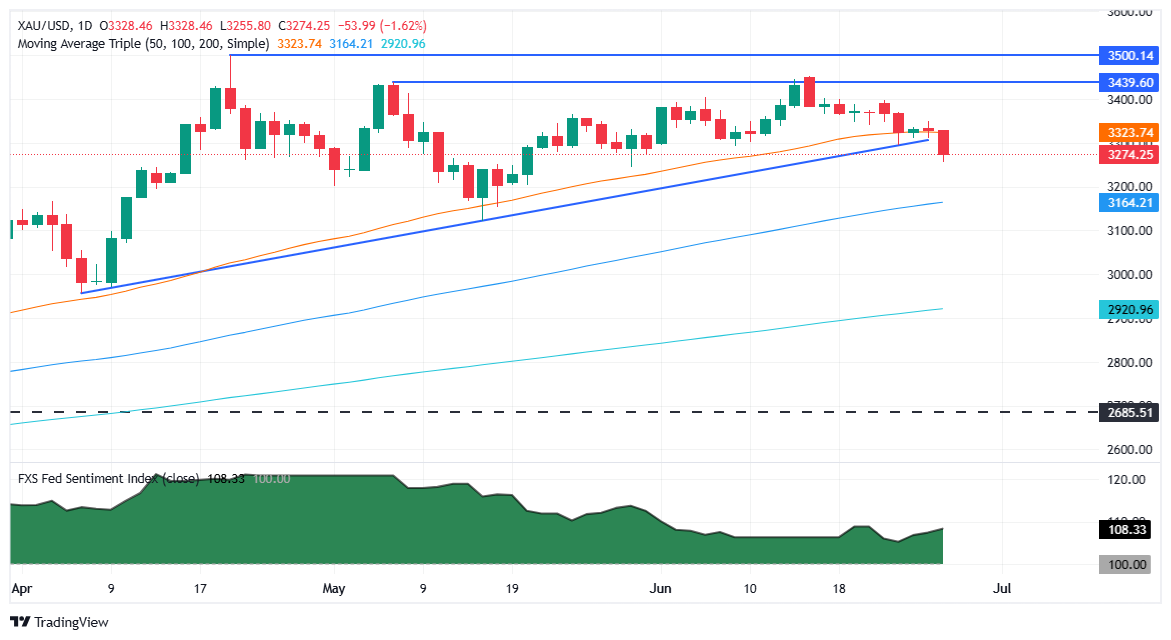Created
: 2025.06.28














![]() 2025.06.28 02:41
2025.06.28 02:41
Gold price tumbled over 1.50% on Friday amid an improvement in risk appetite, driven by several factors. The de-escalation of the Israel-Iran conflict, the trade agreement with China, and ongoing negotiations between the United States (US) and its peers to reach commercial deals were welcomed by investors, who had previously sought refuge in Bullion's safe-haven demand.
The XAU/USD trades at $3,274 after hitting a daily high of $3,328. On Thursday, the White House announced that the US and China have formally signed a trade agreement, effectively ending the ongoing "trade war." US Commerce Secretary, Howard Lutnick, said that additional deals are looming as the July 9 deadline approaches.
Regarding geopolitics, Iran has shown signs of flexibility, leaning toward diplomacy, as its representative in the UN said that Tehran is open to forming a regional nuclear consortium in the event of an agreement with Washington.
Adding to the upbeat mood is the possibility of the end of the Israel-Gaza war within two weeks, revealed Al Arabiya.
In the US, the Federal Reserve's (Fed) preferred inflation gauge, the core Personal Consumption Expenditures (PCE) Price Index, came in line with estimates in May but failed to show any progress toward disinflation.
Earlier, the Minneapolis Fed's Neel Kashkari commented that he still sees two rate cuts in 2025.

Source: Prime Market Terminal
Gold price uptrend remains in place, but in the short term, it could drop further after breaking below the 50-day Simple Moving Average (SMA) at $3,323. The Relative Strength Index (RSI) indicates that momentum has turned bearish despite the price action achieving higher highs and higher lows.
For a bullish continuation, XAU/USD must climb past $3,300. The following key resistance would be the 50-day SMA at $3,323, followed by the June 26 peak of $3,350. If surpassed, up next is $3,400. On the flip side, if XAU/USD tumbles below $3,300, the May 29 low of $3,245 and $3,200 are up for grabs.

Gold has played a key role in human's history as it has been widely used as a store of value and medium of exchange. Currently, apart from its shine and usage for jewelry, the precious metal is widely seen as a safe-haven asset, meaning that it is considered a good investment during turbulent times. Gold is also widely seen as a hedge against inflation and against depreciating currencies as it doesn't rely on any specific issuer or government.
Central banks are the biggest Gold holders. In their aim to support their currencies in turbulent times, central banks tend to diversify their reserves and buy Gold to improve the perceived strength of the economy and the currency. High Gold reserves can be a source of trust for a country's solvency. Central banks added 1,136 tonnes of Gold worth around $70 billion to their reserves in 2022, according to data from the World Gold Council. This is the highest yearly purchase since records began. Central banks from emerging economies such as China, India and Turkey are quickly increasing their Gold reserves.
Gold has an inverse correlation with the US Dollar and US Treasuries, which are both major reserve and safe-haven assets. When the Dollar depreciates, Gold tends to rise, enabling investors and central banks to diversify their assets in turbulent times. Gold is also inversely correlated with risk assets. A rally in the stock market tends to weaken Gold price, while sell-offs in riskier markets tend to favor the precious metal.
The price can move due to a wide range of factors. Geopolitical instability or fears of a deep recession can quickly make Gold price escalate due to its safe-haven status. As a yield-less asset, Gold tends to rise with lower interest rates, while higher cost of money usually weighs down on the yellow metal. Still, most moves depend on how the US Dollar (USD) behaves as the asset is priced in dollars (XAU/USD). A strong Dollar tends to keep the price of Gold controlled, whereas a weaker Dollar is likely to push Gold prices up.
![]()
Created
: 2025.06.28
![]()
Last updated
: 2025.06.28

FXStreet is a forex information website, delivering market analysis and news articles 24/7.
It features a number of articles contributed by well-known analysts, in addition to the ones by its editorial team.
Founded in 2000 by Francesc Riverola, a Spanish economist, it has grown to become a world-renowned information website.
We hope you find this article useful. Any comments or suggestions will be greatly appreciated.
We are also looking for writers with extensive experience in forex and crypto to join us.
please contact us at [email protected].
Disclaimer:
All information and content provided on this website is provided for informational purposes only and is not intended to solicit any investment. Although all efforts are made in order to ensure that the information is correct, no guarantee is provided for the accuracy of any content on this website. Any decision made shall be the responsibility of the investor and Myforex does not take any responsibility whatsoever regarding the use of any information provided herein.
The content provided on this website belongs to Myforex and, where stated, the relevant licensors. All rights are reserved by Myforex and the relevant licensors, and no content of this website, whether in full or in part, shall be copied or displayed elsewhere without the explicit written permission of the relevant copyright holder. If you wish to use any part of the content provided on this website, please ensure that you contact Myforex.
Myforex uses cookies to improve the convenience and functionality of this website. This website may include cookies not only by us but also by third parties (advertisers, log analysts, etc.) for the purpose of tracking the activities of users. Cookie policy